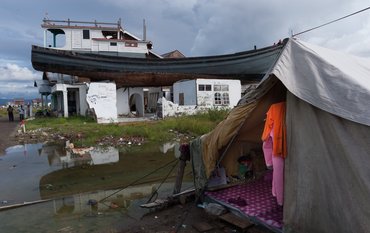Explosive volcanic eruptions often announce themselves: The dynamic of gas and magma flows inside the mountain change noticeably before eruptions and cause, among other things, the rising and lowering of the volcano's surface, which is recorded by satellites. To better analyse and interpret such changes, an interdisciplinary team led by Binayak Ghosh and Mahdi Motagh from the German Research Centre for Geosciences Potsdam (GFZ) has further developed machine learning methods to detect, using satellite measurements, even very small surface deformations automatically. Their results were published in the "IEEE Journal of Selected Topics in Applied Earth Observations and Remote Sensing". Their findings provide an important basis for analysing the growing amounts of satellite data on more than 1,500 active volcanoes worldwide virtually in near real time, and thus ultimately providing more precise warnings of eruptions.
How to detect and interpret the signs of impending volcanic eruptions early and precisely is being researched at the GFZ with an interdisciplinary approach. “The assessment of volcanic activity is determined by various parameters," explains volcanologist Thomas Walter. "These include seismic measurements, observations of temperature, the composition of released gases - and the often very complex surface deformation." The latter is in the focus of the presented research.
The breathing of volcanoes
Even in Greek mythology, there are analogies between volcanic activity and human breathing. And indeed: the surface of many volcanoes rises and falls measurably, almost as if they were breathing in before they spew out gas, ash or lava. Such bulges and subsidences are now recorded by satellites orbiting the Earth. With the help of special radar technologies, the satellites allow to get imagery from the Earth’s surface in all weather conditions. Each time they orbit the Earth, one can compare the reflected microwaves with the previous one and use it to calculate an interference pattern that reflects the changes in the ground.
Ground surface deformations occurring at volcanoes, however, are often only in the order a few millimetres to centimetres. In the satellite recordings, they are superimposed by fluctuations in physical characteristics of the ground surface or by atmospheric artefacts. The newly developed method of computer-assisted data analysis brings significant progress in the interpretation of satellite images. It was developed by Binayak Ghosh and Mahdi Motagh, head of the working group Radar and optical remote sensing for geohazards at the GFZ Remote Sensing and Geoinformatics section, in cooperation with Thomas Walter, head of the working group volcano-tectonics and -hazards at the GFZ Earthquake and Volcano Physics section, and colleagues from the GFZ, Leibniz University Hannover and the Eberhard Karls University Tübingen.
New machine learning approaches
Until now, satellite images had to be viewed and evaluated manually by scientists. In particular, changes that last only for a short period of time are often less examined, although they can provide important information about the inner processes of a volcano. In order to decipher the superimposed signals in the satellite images, scientists around the world have already used artificial intelligence in recent years. Ghosh and Motagh have now adopted a new approach to optimise previous ML algorithms. "Our approach is based on the application of the Independent Component Analysis (ICA), which tries to extract the latent deformation signals from the satellite measurements. The minimum spanning tree-based approach then compares the multiple iterations of this ICA algorithm and filters out those signals that are most likely to indicate actual surface displacements based on statistical significance.”
Field test on Mexico's Volcán de Colima - with additional insights
Ghosh and Motagh tested their method on several data sets, including satellite images of the Volcán de Colima in western Mexico. Their algorithms detected several episodes of previously unnoticed deformation events. "It is possible that volcanoes rise and fall even more frequently than we previously knew," explains co-author Walter. "In our various case studies, we were able to detect signs of both newly occurring deformations and changes in ongoing deformation processes," adds Motagh. "Our study shows that the computer-assisted evaluation of satellite images using our new algorithms detects episodes of surface deformation much more precisely and reliably than before," concludes Ghosh. "Such a quasi-automated procedure is urgently needed to evaluate the constantly growing amount of observation data from the approximately 1500 active volcanoes," Walter emphasises.
Real-time analysis possible
"Our goal is to observe volcanic activity in near real time," says the volcanologist. His colleague Motagh explains the concrete idea for the technical use of the new analysis method: "The satellite data are freely available. Highly precise and reliable algorithms like the one we developed could evaluate the images even directly in cloud computing platforms," he says. This would eliminate the time and efforts needed to download and process the huge amounts of data locally. "The algorithms could reveal changing activity patterns of volcanoes at an early stage," Motagh explains. "This kind of model-based flagging gives us clues about potentially important volcanic events, especially harbingers of impending eruptions," Walter adds. "As a result, it enables decisions to be made in time on how to proceed." The automatic analysis and interpretation of the available satellite data can also help researchers to describe the periodic behaviour of volcanoes in more detail in the long term.
(Text: Ulrike Schneeweiß)
Funding: This work was supported by the HEIBRiDS Research School and partly by the Helmholtz Incubator Pilot Project TECVOLSA.
Original study: B. Ghosh, M. Motagh, M. H. Haghighi, M. S. Vassileva, T. R. Walter and S. Maghsudi, "Automatic Detection of Volcanic Unrest Using Blind Source Separation With a Minimum Spanning Tree Based Stability Analysis," IEEE Journal of Selected Topics in Applied Earth Observations and Remote Sensing, vol. 14, pp. 7771-7787, 2021, DOI: 10.1109/JSTARS.2021.3097895
Scientific contact:
Prof. Dr. Mahdi Motagh
Section Remote Sensing and Geoinformatics
Helmholtz Centre Potsdam
GFZ German Research Centre for Geosciences
Telegrafenberg
14473 Potsdam
Phone: +49 331 288-1197
Email: mahdi.motagh@gfz-potsdam.de
Twitter: @MahdiMotagh
Prof. Dr. Thomas Walter
Section Physics of Earthquakes and Volcanoes
Helmholtz Centre Potsdam
GFZ German Research Centre for Geosciences
Telegrafenberg
14473 Potsdam
Phone: +49 331 288-1253
Email: thomas.walter@gfz-potsdam.de
Media contact:
Dr. Uta Deffke
Public and Media Relations
Helmholtz Centre Potsdam
GFZ German Research Centre for Geosciences
Telegrafenberg
14473 Potsdam
Phone: +49 331 288-1049
Email: uta.deffke@gfz-potsdam.de













![[Translate to English:] [Translate to English:] Abror Gafurov von dem Schriftzug "Welcome to Azerbaijan" und den UN und COP Logos](/fileadmin/_processed_/2/5/csm_2024_11_Baku_COP29_Abror_Gafurov_1042faec82.jpeg)


![[Translate to English:] Martin Herold standing in front of the library on the Telegrafenberg](/fileadmin/_processed_/c/d/csm_Martin_Herold_d385ee4dd9.jpeg)
![[Translate to English:] Many people are listening to a presentation in the GFZ lecture hall.](/fileadmin/_processed_/c/a/csm_1_Bild1_hell_b9c0e9f5ed.jpeg)






![[Translate to English:] Both scientists sitting on stools in front of a wall of books in the Telegrafenberg library](/fileadmin/_processed_/6/6/csm_Buiter_Castell_DORA_4_e87cb1ea18.jpeg)
![[Translate to English:] Gruppenbild mit 4 Personen](/fileadmin/_processed_/8/d/csm_20241017_GFZ-Emmerman-Medal-005_web_reinhardtundsommer_21a414fa4a.jpeg)






![[Translate to English:] Ice landscape with five red tents](/fileadmin/_processed_/8/9/csm_Zeltlager_auf_dem_Eis_Urheberin_Jenine_McCutcheon_5ced2d523b.jpeg)
